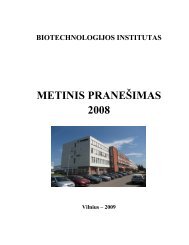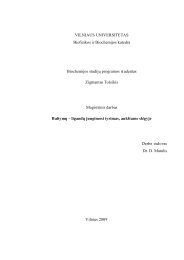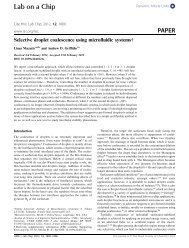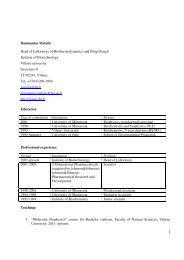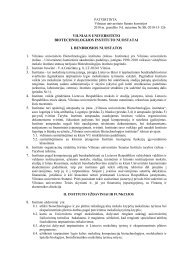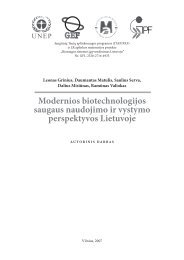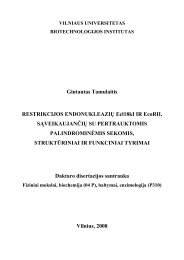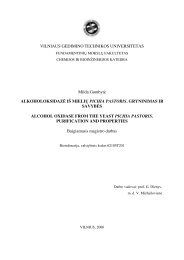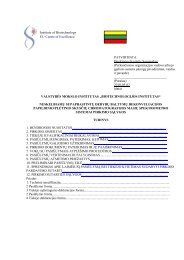Determination of the thermodynamics of carbonic anhydrase acid ...
Determination of the thermodynamics of carbonic anhydrase acid ...
Determination of the thermodynamics of carbonic anhydrase acid ...
You also want an ePaper? Increase the reach of your titles
YUMPU automatically turns print PDFs into web optimized ePapers that Google loves.
1044 L. Baranauskienė et al. / J. Biochem. Biophys. Methods 70 (2008) 1043–1047<br />
5 °C by titrating <strong>the</strong> protein with <strong>acid</strong> at constant temperature in<br />
ITC. The two methods give essentially <strong>the</strong> same result at about<br />
40 °C. Fur<strong>the</strong>rmore, <strong>the</strong> enthalpy <strong>of</strong> unfolding falls on <strong>the</strong> same<br />
temperature trend. As expected, <strong>the</strong> heat capacity <strong>of</strong> unfolding is<br />
positive. Unexpectedly, however, <strong>the</strong> Δ u C p is found to increase<br />
with temperature. In a previous study <strong>of</strong> <strong>the</strong> temperature dependence<br />
<strong>of</strong> Δ u C p , <strong>the</strong> specific heat capacity increments <strong>of</strong> protein<br />
unfolding were found to decrease with increased temperature<br />
[1].<br />
It is important to determine <strong>the</strong> enthalpy <strong>of</strong> protein unfolding<br />
at physiological temperature in pharmaceutical industry when<br />
carrying out ligand binding screening using any type <strong>of</strong> <strong>the</strong>rmal<br />
shift assay, such as <strong>the</strong> ThermoFluor® assay [11,12]. This assay<br />
uses unfolding enthalpy (Δ u H) at 37 °C to determine <strong>the</strong> ligand<br />
binding constant (K b ) at 37 °C. The K b strongly depends on <strong>the</strong><br />
accuracy <strong>of</strong> Δ u H determination, yet it is <strong>of</strong>ten difficult or<br />
impossible to find appropriate <strong>the</strong>rmal denaturation conditions<br />
that afford accurate direct determination <strong>of</strong> unfolding parameters<br />
for most proteins at such a low temperature. Here we suggest that<br />
<strong>the</strong> protein <strong>acid</strong>-unfolding reaction as followed by ITC can be<br />
used as a general method to determine <strong>the</strong> Δ u H at 37 °C.<br />
2. Materials and methods<br />
2.1. Materials<br />
Carbonic <strong>anhydrase</strong> II (from bovine, bCAII) was purchased<br />
from Sigma (St. Louis, MO) and used without fur<strong>the</strong>r purification.<br />
Concentration <strong>of</strong> <strong>the</strong> protein was determined spectrophotometrically<br />
using ε 280 =52,000 M -1 cm -1 . Hydrochloric<br />
<strong>acid</strong> and NaCl were reagent grade chemicals. MiliQ (Millipore)<br />
deionized water was used in <strong>the</strong> study.<br />
2.2. Iso<strong>the</strong>rmal titration calorimetry<br />
greatly. Peaks were positive (exo<strong>the</strong>rmic, note that Calorimetry<br />
Sciences Corporation calorimeters use opposite sign standard<br />
than MicroCal ITC) at 5 °C and negative (endo<strong>the</strong>rmic) at<br />
37 °C.<br />
Since <strong>the</strong> unfolding reaction is slow, we did not wait for<br />
complete heat evolution and added next HCl portion before <strong>the</strong><br />
completion <strong>of</strong> relaxation to baseline. Since <strong>the</strong> heat continued to<br />
evolve and <strong>the</strong> baseline was not reached, a linear baseline was<br />
drawn to integrate an entire area. In Fig. 2, one can see that <strong>the</strong><br />
endo<strong>the</strong>rmic peaks are larger at higher temperatures because <strong>the</strong><br />
enthalpy <strong>of</strong> unfolding is more endo<strong>the</strong>rmic at higher temperatures.<br />
Fig. 3 shows integrated iso<strong>the</strong>rmal titration calorimetry<br />
curves. At higher temperatures, <strong>the</strong> endo<strong>the</strong>rmic heats were<br />
larger and <strong>the</strong> unfolding reaction was faster. However, between<br />
55 °C and 59 °C <strong>the</strong>re was a steep drop in <strong>the</strong> observed heat.<br />
DSC data show that <strong>the</strong> midpoint (T m ) <strong>of</strong> <strong>the</strong>rmal denaturation<br />
<strong>of</strong> <strong>the</strong> protein is about 64 °C, and since <strong>the</strong>re is a large<br />
preequilibration period (about 1 h) in ITC, <strong>the</strong> protein is partially<br />
unfolded at 59 °C even before <strong>the</strong> titration with <strong>acid</strong><br />
begins. Fig. 4 shows <strong>the</strong> ITC data obtained at lower temperatures.<br />
The observed reaction changes sign and becomes<br />
exo<strong>the</strong>rmic at temperatures below 17 °C.<br />
By summing up <strong>the</strong> enthalpies during <strong>the</strong> course <strong>of</strong> titration,<br />
we obtain <strong>the</strong> integral molar enthalpies <strong>of</strong> <strong>carbonic</strong> <strong>anhydrase</strong><br />
unfolding as a function <strong>of</strong> temperature. The black squares in<br />
Fig. 5 show <strong>the</strong> enthalpies (Δ u H ITC ) obtained by integrating <strong>the</strong><br />
<strong>acid</strong> titration curves in Figs. 3 and 4. Open triangles show<br />
calorimetric enthalpies <strong>of</strong> unfolding measured by DSC (Δ u H DSC ).<br />
The DSC experiments were described earlier [10]. The different<br />
protein melting temperatures in DSC experiments were obtained<br />
by altering <strong>the</strong> pH.<br />
Fig. 5 shows that <strong>the</strong>re is a clearly non-linear increase in Δ u H<br />
as a function <strong>of</strong> temperature. Both ITC and DSC datasets seem<br />
to fall on <strong>the</strong> same trend. There is also quite good congruence<br />
Carbonic <strong>anhydrase</strong> was dissolved in 100 mM NaCl aqueous<br />
solution <strong>of</strong> pH 6–7 to <strong>the</strong> final concentration <strong>of</strong> 0.5–2 (usually<br />
1.0) mg/ml. The protein solution was loaded into <strong>the</strong> Nano ITC-<br />
III iso<strong>the</strong>rmal titration calorimeter (Calorimetry Sciences<br />
Corporation) cell (about 1.2 ml, cell volume 1.025 ml). The<br />
titration syringe (250 µl volume) was filled with 5 to 30 (usually<br />
10) mM HCl containing 70 to 95 (usually 90) mM NaCl.<br />
Titrations were carried out using 25 injections <strong>of</strong> 10 µl each,<br />
injected at 3 to 15 minute intervals. Stirring speed was 150 rpm.<br />
Titrations were carried out at constant temperature in <strong>the</strong> 5–<br />
60 °C temperature range.<br />
3. Results<br />
The <strong>acid</strong>-unfolding <strong>of</strong> <strong>carbonic</strong> <strong>anhydrase</strong> was studied using<br />
iso<strong>the</strong>rmal titration calorimetry (ITC). Hydrochloric <strong>acid</strong> was<br />
injected into <strong>the</strong> unbuffered protein solution in <strong>the</strong> presence <strong>of</strong><br />
NaCl. Fig. 1 shows an unfolding titration carried out at 37 °C,<br />
and shows <strong>the</strong> control titration to determine <strong>the</strong> heat <strong>of</strong> <strong>acid</strong><br />
dilution in <strong>the</strong> absence <strong>of</strong> protein at 37 °C. Fig. 2 shows several<br />
ITC raw data curves obtained at 5, 15, 25, and 37 °C. The<br />
titration pr<strong>of</strong>iles obtained at different temperatures varied<br />
Fig. 1. Iso<strong>the</strong>rmal titration calorimetry raw data–titration <strong>of</strong> <strong>carbonic</strong> <strong>anhydrase</strong><br />
with HCl (black line, Unfolding) and <strong>of</strong> <strong>the</strong> same titration in <strong>the</strong> absence <strong>of</strong><br />
protein (grey line, Dilution). Endo<strong>the</strong>rmic heat evolved upon protein unfolding<br />
is visualized by large peaks pointing downwards. Heat <strong>of</strong> HCl dilution is<br />
relatively small. Both shown titrations were carried out at 37 °C.



